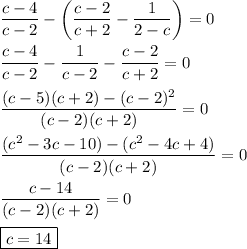9514 1404 393
Answer:
c = 14
no extraneous solutions
Explanation:
You can subtract the right-side expression, combine fractions, and set the numerator to zero.

__
Check
(14 -4)/(14 -2) = (14 -2)/(14 +2) -1/(2 -14) . . . . substitute for c
10/12 = 12/16 -1/-12
5/6 = 3/4 +1/12 . . . . true
There is one solution (c=14) and it is a solution to the original equation. There are no extraneous solutions.